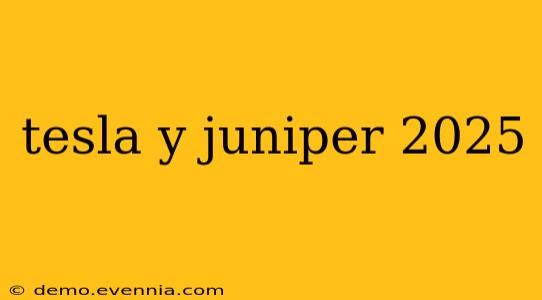The year is 2025. Autonomous vehicles are becoming increasingly commonplace, and the demand for high-speed, reliable connectivity is exploding. This is where the seemingly disparate worlds of Tesla's Model Y and Juniper Networks might collide in a fascinating synergy. While not an official partnership (at the time of writing), exploring the potential intersection of these two tech giants offers valuable insights into the future of automotive technology.
The Model Y's Connectivity Needs: A Growing Appetite
Tesla's Model Y, a popular electric SUV, relies heavily on robust internet connectivity for various features. These include:
- Over-the-air (OTA) updates: Keeping the vehicle's software current requires a reliable and high-bandwidth connection. OTA updates are crucial for improving performance, adding new features, and addressing bugs.
- Navigation and mapping: Real-time traffic information, accurate route guidance, and access to points of interest depend on a consistent internet connection.
- Streaming entertainment: Passengers often use in-car entertainment systems, requiring sufficient bandwidth to stream music, movies, and other media.
- Autonomous driving capabilities: Advanced driver-assistance systems (ADAS) and full self-driving (FSD) features rely on constant communication with Tesla's servers and potentially other infrastructure for data processing and decision-making. This requires a very reliable and low-latency network.
Juniper Networks: Powering the Next Generation of Automotive Networks
Juniper Networks is a leader in providing networking solutions for high-performance environments. Their expertise in routing, switching, and security could play a vital role in addressing the growing connectivity demands of electric vehicles like the Tesla Model Y. Specifically, Juniper’s technologies could contribute to:
- Edge computing solutions: Processing vast amounts of data generated by autonomous driving systems requires powerful edge computing capabilities, a space where Juniper excels. Processing data closer to the source reduces latency and improves the overall responsiveness of the vehicle's systems.
- Enhanced network security: Protecting vehicle data from cyber threats is crucial. Juniper's security solutions can help safeguard sensitive information transmitted between the vehicle and the cloud.
- High-bandwidth connectivity: Juniper's networking equipment can support the high bandwidth required for streaming, OTA updates, and other data-intensive applications within the vehicle and its connection to external networks.
- Scalability and reliability: As the number of connected vehicles increases, Juniper's scalable solutions can accommodate the growing demand for network capacity and ensure reliable connectivity for all vehicles.
Potential Synergies for 2025 and Beyond
While there's no public announcement of a direct collaboration between Tesla and Juniper Networks, the potential for synergy is clear. Imagine a future where Juniper's technology forms the backbone of Tesla's vehicle network, ensuring seamless connectivity and enabling the full potential of advanced features. This could involve:
- Private 5G networks: Juniper's expertise in 5G technology could be leveraged to create private, high-performance networks for Tesla's vehicles, enhancing communication reliability and security.
- Integration with Tesla's infrastructure: Juniper's solutions could be integrated with Tesla's existing infrastructure, improving the efficiency and scalability of their data centers and network operations.
Conclusion: A Look Ahead
The potential for a future partnership between Tesla and Juniper Networks is exciting. The combination of Tesla's innovative electric vehicles and Juniper's cutting-edge networking technology could revolutionize the automotive industry, paving the way for safer, more connected, and more enjoyable driving experiences. While this is speculative, exploring the technological possibilities highlights the evolving landscape of connected vehicles and the critical role of robust networking infrastructure in their success. The coming years will undoubtedly reveal more about the collaborations that shape the future of autonomous driving and the connected car ecosystem.

